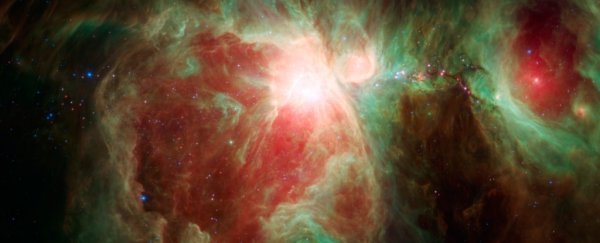What we thought may have been an off-switch for star formation doesn't appear to work that way after all.
New observations from the Hubble Space Telescope show the powerful astrophysical jets and stellar winds that flow from baby stars do not have the expected effect of quenching the stellar growth process. This poses quite a significant conundrum for our models of star formation.
The birth of a star is quite a long process on human timescales. It's not as if we can sit and watch a baby star form from go to whoa. What we can do is find a bunch of stars at different stages of the formation process and put the pieces together like a puzzle.
The most commonly accepted model goes thus: Firstly, you need to start with a really dense clump of material in a cloud of cool, interstellar molecular gas.
With enough density, the clump collapses under its own gravity to form a protostar, which starts to spin. This spin causes the material in the cloud around it to form a disk, which spools into the growing star like water down a drain, inexorably drawn in by its strengthening gravitational pull.
But only 30 percent of the initial cloud's mass ends up in the star. Until now, we actually had a pretty good explanation as to why: As the star grows, it starts to produce a powerful stellar wind. In addition, material falling into the star starts to interact with the star's magnetic fields, flowing along magnetic field lines to the poles, where it is blasted into space in the form of powerful plasma jets.
The combined outward push of these two forces, known as stellar feedback, carves a larger and larger cavity into the molecular cloud around the star, eventually depriving it of material for further growth, and determining the final mass of the star.
Or so we thought.
 (R. B. Andreo/DeepSkyColors.com, NASA, ESA, STScI, N. Habel and S. T. Megeath/University of Toledo)
(R. B. Andreo/DeepSkyColors.com, NASA, ESA, STScI, N. Habel and S. T. Megeath/University of Toledo)
In a study of 304 protostars in the Orion Complex star-forming region, highlighted in yellow in the image above, astronomers have found no evidence that the outflow cavities grow steadily as the star rapidly grows.
"In one stellar formation model, if you start out with a small cavity, as the protostar rapidly becomes more evolved, its outflow creates an ever-larger cavity until the surrounding gas is eventually blown away, leaving an isolated star," said astronomer Nolan Habel of the University of Toledo.
"Our observations indicate there is no progressive growth that we can find, so the cavities are not growing until they push out all of the mass in the cloud. So, there must be some other process going on that gets rid of the gas that doesn't end up in the star."
The study required data from a number of space telescopes. The Herschel Space Observatory and Spitzer Space Telescope had conducted surveys of the Orion Complex to build a catalog of hundreds of protostars. Based on the light of these stars in the surveys, Habel and his team sorted the protostars by age.
Then, they took observations of the surrounding cloud region in near-infrared using Hubble; some of these are pictured below. Although optical light can't penetrate a protostellar cloud, infrared wavelengths can, and infrared observations are an excellent tool for probing into densely clouded regions.
In this case, the light of the forming star reflects off the boundaries of the cavity, which allows astronomers to map its size.
 (NASA, ESA, STScI, N. Habel and S. T. Megeath/University of Toledo)
(NASA, ESA, STScI, N. Habel and S. T. Megeath/University of Toledo)
This painstaking work resulted in a catalog of protostars and their cavities, sorted by age… and older protostars did not seem to have larger cavities.
"We find that at the end of the protostellar phase, where most of the gas has fallen from the surrounding cloud onto the star, a number of young stars still have fairly narrow cavities," said astronomer Tom Megeath of the University of Toledo.
"So, this picture that is still commonly held of what determines the mass of a star and what halts the infall of gas is that this growing outflow cavity scoops up all of the gas. This has been pretty fundamental to our idea of how star formation proceeds, but it just doesn't seem to fit the data here."
Although it's still possible that the winds and jets play some role in star formation, that role doesn't seem to be nearly as important as we thought, the researchers said. It's possible that slower, higher density outflows could be responsible - a similar mechanism, but one that takes a longer time to clear the cavity - but without more detailed observations, it's impossible to tell.
So, that will be one of the next steps. No doubt astronomers will also be looking to model and simulate star formation - to try and identify other mechanisms that could call a halt to growth with a much smaller contribution from stellar feedback. Watch this space.
The team's research is due to appear in The Astrophysical Journal, and is available on arXiv.
